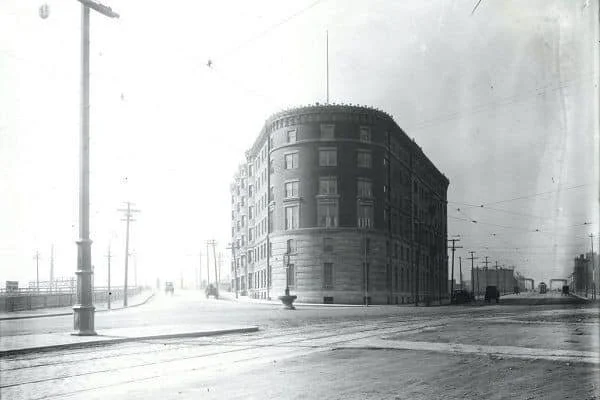
The bellhop in hazmat suit will take you to your lab
The Hotel Buckminster (built in 1897), at Boston’s Kenmore Square, in about 1900; space for the future Fenway Park is at left. The shuttered hotel will reportedly be bought for $42.5 million by development company IQHQ and turned into — what else these days in Boston and Cambridge!? —biotech lab space.
The hotel was where the plot to fix the 1919 World Series was allegedly launched.
2009 photo
— Photo by John Stephen Dwyer
John O. Harney: September song -- jobs, demographics, town & gown, etc.
September, from the Très Riches Heures du Duc de Berry.
Via the New England Board of Higher Education (nebhe.org)
Post-Labor Days. For many, that means time to put away the white pants and relish that last summer getaway. Few will reflect on the true meaning of Labor Day (and May Day) or the too-often-denigrated labor movement in general. Fewer will think of the 19th Century mill girls in Lowell, Mass., and their successors who risked their jobs—and sometimes their lives—to create the day of recognition for workers. Many of today’s employers keep their shifts going even during Labor Day. Many professionals dabble with work even during the paid time off the labor movement won for them (though even today the U.S. is the only "first world economy" that doesn’t require employers to offer any paid time off).
As historian Charles Scontras, of the University of Maine’s Bureau of Labor Education, recently noted, “Workers whose knowledge and skills are increasing[ly] linked to increased productivity and the creation of wealth, and who may have viewed with indifference the movement of manufacturing abroad for the past few decades are, themselves, increasingly experiencing living on the edge of economic insecurity.” Many students, meanwhile, got back to class in late August; speed counts. Labor Day is not what it used to be.
But labor is more crucial than ever.
Indeed, NEBHE’s Commission on Higher Education & Employability is heating up. The Commission will host a panel discussion at NEBHE’s board meeting on Sept. 14 in Maine, a full Commission meeting on Sept. 27 at Carbonite, in Boston, and a summit Dec. 4 at the Federal Reserve Bank of Boston.
The Commission is not some set of crass commercial tasks, but rather a deliberate initiative to help all New Englanders find fulfilling jobs and, in so doing, enrich the region’s economy. One concern for the Commission is bringing adult workers into the workplace to capitalize on the aging of the region's population; Maine, Vermont and New Hampshire have the oldest median agesin America. Why not go a step further and redouble efforts to make New England a world leader in all things geriatric, including deploying the region’s fabled health research expertise in a well-funded, concentrated fight against the scourge of Alzheimer’s disease?
The other side of New England's demographic challenge is the need to engage groups who have not always been well-served by education. Obviously, Donald Trump’s suggestion to end Deferred Action for Childhood Arrivals (DACA) will not help.
A different brain drain. On the subject of age, New England is losing its claim to an 88-year-old genius. Famed left-wing social critic Noam Chomsky announced last month that he is leaving MIT, where he has been a linguistics professor since 1955, to join the linguistics department at the University of Arizona. Brain drain is a common worry. And the drain is often the Sun Belt (at least before climate change was understood). But the brain drain is more commonly seen through the lens of New England losing workers than losing intellectual capital, especially academics such as Chomsky who have lost favor among corporate-minded higher ed thinkers.
You work too much. Most students (59 percent) work during college. But like countless moms advised, the key is moderation. Working while in college can be a good strategy for students from low-income families to get through and get ahead in college, especially if their enlightened employers offer flexibility. But an ACT Center for Equity for Learning report suggests that working more than 15 hours a week while in college may do more harm than good—especially for students from underserved backgrounds.
The findings come just as the Trump administration proposes cutting $500 million from the federal work-study program; some estimate that would lead to only 333,000 students awarded work-study aid in 2018, compared with 634,000 in 2017.
College readiness is inherently involved in the employability effort. Even in the age of alternative credentials, higher education of some sort is critical to the region’s employability future. Much talked-about 21st Century skills generally include: collaboration ("teamwork"); communication; critical thinking (though more about solving problems than being critical of authority or mass media) and creativity (as long as it can be monetized?). Having been in Boston’s Kenmore Square around the Hub’s famed Sept. 1 move-in days, I would add one more: the ability to walk down a street without knocking anyone over.
Relevant for future enrollment? The Maine House considered a proposal to allow people with concealed carry permits to carry their firearms on public colleges (except in facilities that post signs barring them). The idea was rejected. The bill would have changed existing law that lets the trustees of the University of Maine, the Maine Community College System and the Maine Maritime Academy decide the rules for the campuses they oversee. In a line straight out of Miss Sloane, bill sponsor Rep. Richard Cebra (R.-Naples) said the proposal is “a women’s issue” because “a small, concealed handgun creates an equality between a 100-pound woman and a 225-pound attacker.” Cebra and two colleagues also requested allowing members of the Legislature to carry concealed handguns in the statehouse, following a gun attack in Virginia on a congressional baseball practice. Across the region, Massachusetts bans guns on campus; the other five states leave it up to individual campuses, according to the Campaign to Keep Guns off Campus.
Regional thinking. When we staged our mock election campaign for “Governor of New England” nearly a decade ago, one of the “candidates,” Vermont’s then treasurer, and later real governor, Jim Douglas argued: “We have 250 towns (Maine has 435) and the Legislature offered an incentive a couple of years ago to provide more school construction aid for towns that would consolidate their schools and build a joint school. They pulled back because nobody wanted to do it. So before we talk about expansion and collaboration in the federation beyond the borders, we should realize it is pretty tough to cooperate even internally sometimes.”
Hard as it is to join schools within states, Vermont and New Hampshire towns are among those considering a new interstate district. Previously, Vermont was part of the first joint compact district in the nation, when Norwich, Vt. joined with Hanover, N.H., in 1964 to form the Dresden School District.
Going coed. College readiness and employability both hinge on the economic sustainability of higher ed institutions. One strategy to bolster institutional finances has been to appeal to more groups of students. The University of Saint Joseph (USJ) announced last month that it will open undergraduate admissions to male students for fall 2018. Historically, USJ admitted only women to its main undergrad programs, but began introducing coeds to various graduate programs starting in 1959. President Rhona Free cited studies showing that less than 1% of full-time female college students attend a women’s college and only 2% of female high school seniors say they’d consider attending one.
Play ball! Major League Baseball (MLB) and Northeastern University entered a partnership to provide pro ballplayers with access to higher-education programs. The agreement follows the inclusion of a new Continuing Education Program in MLB’s collective-bargaining agreement, which provides players with additional funds devoted to their educational development.
Northeastern President Joseph E. Aoun, who is slated to speak at the NEBHE Dec. 4 summit, said of the baseball agreement: "We must be boundless, and meet learners where they are. That is why this partnership with Major League Baseball—to prepare players at all levels for the next step in their lives and careers—is so important." The agreement provides a range of opportunities to interested players—both during and following their baseball careers—through in-person and online instruction. Players will have access to degree programs in fields such as finance, health sciences, information technology, human services, communications and psychology, data analytics, sports leadership, digital media and project management.
Peace in Maine. The Lewiston, Maine, police have been holding neighborhood meetings to address complaints about Bates College off-campus housing. Lewiston Mayor Bob Macdonald was quoted in the Lewiston-Auburn Sun Journal as saying: "These are people who have lived there for years, and their quality of life won't be ruined by out-of-state yahoos." NEJHE has covered such delicate town-gown relations, including a full edition on Colleges In Their Places.
Being your Guide. Putting together our annual Guide to New England Colleges and Universities always offers an opportune time to inspect the region’s higher-ed landscape for institutional comings and goings. What’s new this year? Facing declining enrollment, Andover Newton Theological School of Massachusetts signed an agreement to move into Yale Divinity School, in New Haven, Conn., and become Andover Newton Seminary at Yale Divinity School. The former Rockport College connected with the University of Maine Augusta is now Maine Media College. The entire board of the New England Center for Circus Arts (NECCA) stepped down after turmoil between the trustees, the founders and the staff. It sent us scurrying to make sure we hadn’t missed out on the circus, but alas, NECCA doesn’t fit the criteria for the Guide, notably that they be authorized to grant undergraduate or graduate degrees.
A little civility. Former NEBHE chair and frequent NEJHE editorial contributor Lou D’Allesandro reflected on the enactment of a New Hampshire Senate Bill he sponsored to develop a uniform framework for civics courses. “By outlining an instructional framework, this bill ensures that our teachers are teaching the fundamentals of democracy, the responsibilities of every citizen, and the tools to engage. At no additional cost to the state, this is a common sense measure for our students and our democracy.”
Collaborating. I was honored to join the July 2017 ACL Northeast Community Gathering at the Harvard Graduate School of Education. It’s a group of collaborators who could save higher education money by sharing rather than cutting. But the consortia themselves face challenges. Neal Abraham, executive director of Five Colleges Inc., {Amherst, Smith, Mount Holyoke and Hampshire colleges and the University of Massachusetts at Amherst} notes that they are often seen as “cost centers” and collaboration is hardly mentioned to new officials stepping into higher ed leadership positions. At Five Colleges, which has 37 employees and is often seen as a leader among consortia, the directors of virtually every function area have turned over in the past eight years. Abraham, himself, is stepping down.
The featured speakers at the ACL Northeast Community meeting were Harvard Project Zero’s Howard Gardner and Wendy Fischman. They offered “impressions” from their work on “Liberal Arts and Sciences in the 21st Century.” The study investigates how students, parents of students, faculty, administrators, trustees, young alumni and job recruiters conceive of the purposes, best practices and most challenging features of undergraduate education in the U.S., especially liberal arts and sciences. It'll take time to see final results. But in the meantime, Fisher asks: Wouldn't we all want a population that reads the newspaper and understands it?
Missing BIF. For the first time in several years, I’ll be missing this month’s Business Innovation Factory summit, in Providence, due to a conflict. It’s always a profound inspiration. I urge you to watch the videos, which generally are released within a month or so of the event.
John O. Harney is executive editor of The New England Journal of Higher Education, a service ofNEBHE.
A sign for the '60s
Kenmore Square, with the world's most-famous Citgo sign.
Adapted from an item in Robert Whitcomb's "Digital Diary'' in GoLocal24.com
The famous glowing Citgo signatop a building at Boston’s Kenmore Square will be saved, thus keeping fresh in the minds of now aging Baby Boomer potheads a significant landmark from their youth. Boston officials helped broker a deal between Citgoand a real estate company with the weird name of Related Beal to keep the sign up. The current, “psychedelic’’ version of the sign went up in 1965, just in time to appeal to the hordes of mostly young people in the area who were “experimenting’’ with marijuana.
Daniel Bluestone, an architecture-history professor at Boston University, told The Boston Globe he was very happy about the agreement: “It’s a landmark in the truest sense of the word. It helps people know where they are.” Above-the-street landmarks are particularly important in a city with as confused a layout as Boston.
Of course in the late '60s, many people didn't know 24/7 where they were going.






